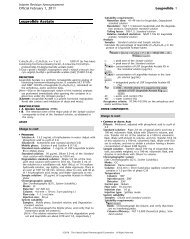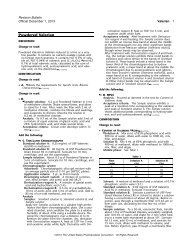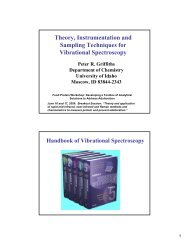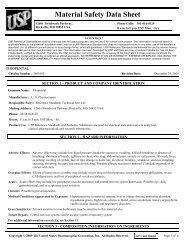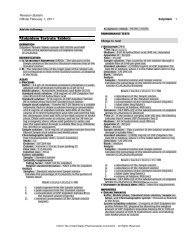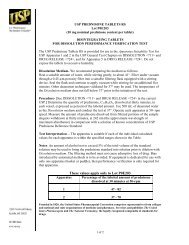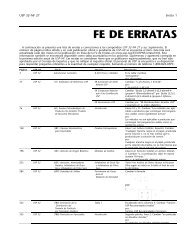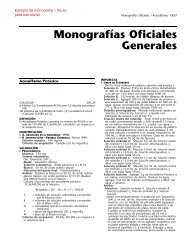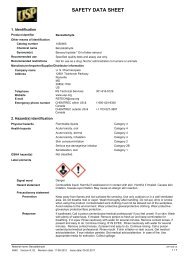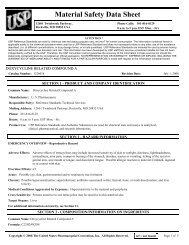SAFETY DATA SHEET - US Pharmacopeial Convention
SAFETY DATA SHEET - US Pharmacopeial Convention
SAFETY DATA SHEET - US Pharmacopeial Convention
You also want an ePaper? Increase the reach of your titles
YUMPU automatically turns print PDFs into web optimized ePapers that Google loves.
4. First-aid measures<br />
Inhalation Move to fresh air. Oxygen or artificial respiration if needed. Do not use mouth-to-mouth method if<br />
victim inhaled the substance. Call a POISON CENTER or doctor/physician if you feel unwell.<br />
Skin contact Rinse skin with water/shower. Get medical attention if irritation develops and persists.<br />
Eye contact Immediately flush eyes with plenty of water for at least 15 minutes. Get medical attention if<br />
irritation develops and persists.<br />
Ingestion Rinse mouth. Get medical advice/attention if you feel unwell.<br />
Most important<br />
symptoms/effects, acute and<br />
delayed<br />
Indication of immediate<br />
medical attention and special<br />
treatment needed<br />
Irritation of eyes and mucous membranes. Vapors have a narcotic effect and may cause<br />
headache, fatigue, dizziness and nausea.<br />
Do not induce vomiting. Perform gastric lavage. For hypotension, infuse 10- 20 mL/kg isotonic<br />
fluid. Administer dopamine or norepinephrine if hypotension persists. For bradycardia, administer<br />
atropine intravenously. For respiratory distress, administer oxygen and assist ventilation. For<br />
malignant hyperthermia, administer 100% oxygen and dantrolene sodium, and reduce body<br />
temperature with external cooling methods, if needed. For acidosis, administer sodium<br />
bicarbonate. For hyperkalemia, administer 100% oxygen, bicarbonate, glucose, and insulin. For<br />
bronchospasm, administer albuterol. For seizures, administer benzodiazepine intravenously.<br />
(Poisindex) (Meditext) Provide general supportive measures and treat symptomatically.<br />
General information Remove from exposure. Remove contaminated clothing. For treatment advice, seek guidance<br />
from an occupational health physician or other licensed health-care provider familiar with<br />
workplace chemical exposures. In the United States, the national poison control center phone<br />
number is 1-800-222-1222. If person is not breathing, give artificial respiration. If breathing is<br />
difficult, give oxygen if available. Persons developing serious hypersensitivity (anaphylactic)<br />
reactions must receive immediate medical attention.<br />
5. Fire-fighting measures<br />
Suitable extinguishing media Water fog. Foam. Dry chemical powder. Carbon dioxide (CO2).<br />
Unsuitable extinguishing Not available.<br />
media<br />
Specific hazards arising from Not applicable.<br />
the chemical<br />
Special protective equipment Wear suitable protective equipment.<br />
and precautions for firefighters<br />
Fire-fighting<br />
equipment/instructions<br />
As with all fires, evacuate personnel to a safe area. Firefighters should use self-contained<br />
breathing equipment and protective clothing.<br />
Specific methods Cool containers exposed to flames with water until well after the fire is out.<br />
6. Accidental release measures<br />
Personal precautions,<br />
protective equipment and<br />
emergency procedures<br />
Methods and materials for<br />
containment and cleaning up<br />
7. Handling and storage<br />
Keep unnecessary personnel away. Do not touch damaged containers or spilled material unless<br />
wearing appropriate protective clothing. Avoid inhalation of vapors. Ensure adequate ventilation.<br />
Wear appropriate personal protective equipment.<br />
Absorb spillage with suitable absorbent material. For waste disposal, see section 13 of the SDS.<br />
Wash spill site.<br />
Precautions for safe handling As a general rule, when handling <strong>US</strong>P Reference Standards, avoid all contact and inhalation of<br />
dust, mists, and/or vapors associated with the material. Clean equipment and work surfaces with<br />
suitable detergent or solvent after use. After removing gloves, wash hands and other exposed<br />
skin thoroughly. Use of a designated area is recommended for handling of potent materials.<br />
Conditions for safe storage,<br />
including any incompatibilities<br />
8. Exposure controls/personal protection<br />
Occupational exposure limits<br />
U.S. - NIOSH<br />
Store in tight container as defined in the <strong>US</strong>P-NF. This material should be handled and stored per<br />
label instructions to ensure product integrity.<br />
Material Type<br />
Value<br />
Form<br />
Enflurane (CAS<br />
13838-16-9)<br />
<strong>US</strong>. ACGIH Threshold Limit Values<br />
Ceiling 2 ppm Waste anesthetic gas<br />
Material Type<br />
Value<br />
Enflurane (CAS<br />
13838-16-9)<br />
TWA 75 ppm<br />
Biological limit values No biological exposure limits noted for the ingredient(s).<br />
Material name: Enflurane<br />
5064 Version #: 03 Revision date: 11-16-2012 Issue date: 10-13-2009<br />
<strong>US</strong>P SDS <strong>US</strong><br />
2 / 7




